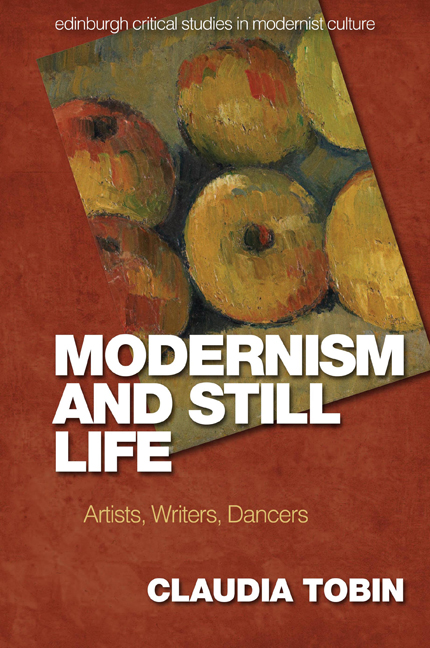Book contents
- Frontmatter
- Contents
- List of Figures and Plates
- List of Abbreviations
- Acknowledgements
- Series Editors’ Preface
- Introduction: ‘Nothing is really statically at rest’: Cézanne and Modern Still Life
- 1 ‘Quivering yet still’: Virginia Woolf, Roger Fry and the Aesthetics of Attention
- 2 Still Life in Motion
- 3 ‘Past the gap where we cannot see’: Still Life and the ‘Numinous’ in British Painting of the 1920s–1930s
- 4 ‘Inactive contemplation’: Wallace Stevens and Charles Mauron
- Conclusion: ‘On the very brink of utterance’: Aldous Huxley, Mark Gertler and Transfigured Things
- Bibliography
- Index
- Plate Section
3 - ‘Past the gap where we cannot see’: Still Life and the ‘Numinous’ in British Painting of the 1920s–1930s
Published online by Cambridge University Press: 08 October 2020
- Frontmatter
- Contents
- List of Figures and Plates
- List of Abbreviations
- Acknowledgements
- Series Editors’ Preface
- Introduction: ‘Nothing is really statically at rest’: Cézanne and Modern Still Life
- 1 ‘Quivering yet still’: Virginia Woolf, Roger Fry and the Aesthetics of Attention
- 2 Still Life in Motion
- 3 ‘Past the gap where we cannot see’: Still Life and the ‘Numinous’ in British Painting of the 1920s–1930s
- 4 ‘Inactive contemplation’: Wallace Stevens and Charles Mauron
- Conclusion: ‘On the very brink of utterance’: Aldous Huxley, Mark Gertler and Transfigured Things
- Bibliography
- Index
- Plate Section
Summary
For the painters considered in this chapter – Winifred Nicholson, Ben Nicholson, Ivon Hitchens and David Jones – still life represented a charged space of experimentation in which the possibilities of heightened and in some cases ‘spiritual‘ vision could be cultivated. It was a way of reaching, in Winifred Nicholson‘s words, ‘past the gap where we cannot see’. Still life was crucial to the development of this loose group of British painters during the 1920s and ‘30s, several of whom have been marginalised in the larger narratives and geographies of modernism (Winifred Nicholson, Hitchens and Jones), or explored largely for their contribution to abstraction (Ben Nicholson). All were at different times members of the Seven and Five Society, the London-based society of artists established in 1919. The Society played a significant role in promoting and exhibiting modern British art over the next two decades, becoming more progressive from 1926 onwards when Ben Nicholson became chairman. By exploring a fertile period of creative exchange between these artists during the 1920s and early 1930s, we can uncover the different ways in which still life became emblematic of an investigation of reality with numinous as well as aesthetic implications. The term ‘numinous’ is employed here in the following significations: ‘revealing or indicating the presence of a divinity’, and ‘giving rise to a sense of the spiritually transcendent; (esp. of things in art or the natural world) evoking a heightened sense of the mystical or sublime’. Under this broad umbrella, we shall see a range of different spiritual orientations and vocabularies emerge.
In 1927, the art critic Herbert Furst published a study devoted to still life, which indicates its position in contemporary discourses. He argued that the genre unfairly remained a ‘victim’ of neglect on three grounds: ‘as the lowest form of pictorial art’, as a ‘dull subject’, and in its commercial value. Despite Furst's recognition that still life played ‘so prominent a part’ in the artistic experiments of the early twentieth century (a recognition he substantiated by exhibiting Ben Nicholson at his London gallery in 1924), he takes us back to the idea of an aesthetic laboratory, defining the genre as ‘the ideal corpus vile [worthless body] upon which all manner of aesthetical experiments can fitly be conducted’.
- Type
- Chapter
- Information
- Modernism and Still LifeArtists, Writers, Dancers, pp. 124 - 159Publisher: Edinburgh University PressPrint publication year: 2020



